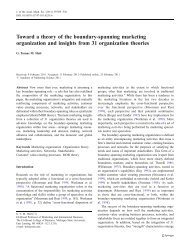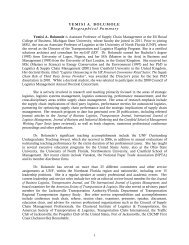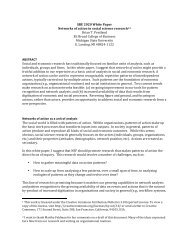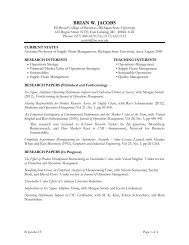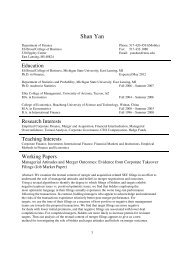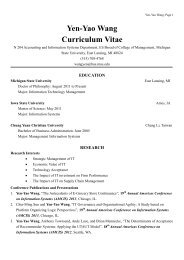Journal of Business logistics, Vol. 28, no. 2, 2007 ... - Global Initiatives
Journal of Business logistics, Vol. 28, no. 2, 2007 ... - Global Initiatives
Journal of Business logistics, Vol. 28, no. 2, 2007 ... - Global Initiatives
You also want an ePaper? Increase the reach of your titles
YUMPU automatically turns print PDFs into web optimized ePapers that Google loves.
114 hult, boyer, and ketchen, Jr.Non-response biasThe extrapolation procedure suggested by Armstrong and Overton (1977) was used to assesspotential <strong>no</strong>n-response bias. When assessing the first quartile versus the last quartile <strong>of</strong> the respondentsin each sample group (semi extended, fully extended, de-coupled, and centralized extendedstrategies), we found <strong>no</strong> significant differences on any <strong>of</strong> the seven summated measures in the survey(i.e., service quality, product quality, e<strong>Business</strong>-quality, attitude toward Internet ordering, online accessibility,sacrifice, and behavioral intentions). Thus, our inference is that the data are free fromsystematic difference bias. Thus, <strong>no</strong>n-response bias does <strong>no</strong>t appear to be an inhibiting factor inanalyzing the hypothesized relationships.Statistical powerFor each operational <strong>logistics</strong> strategy type, we conducted power analysis per the guidelines<strong>of</strong> Cohen, Cohen, West, and Aiken (2003) to determine the probability <strong>of</strong> finding the sample R2 tobe greater than zero with α = 0.01. We achieved excellent statistical power (β > 0.99, p < 0.01) ineach scenario.MeasuresThe measures used in this study are included in the Appendix. Three categories <strong>of</strong> measureswere employed to assess the fit <strong>of</strong> the service, product, and e<strong>Business</strong> quality-pr<strong>of</strong>ile with operational<strong>logistics</strong> strategy types and their effects on customer repurchase intentions: (1) pr<strong>of</strong>ile measures (i.e.,service-, product-, and e<strong>Business</strong>-quality measures), (2) customers’ behavioral repurchase intentions,and (3) control variables (i.e., attitude toward Internet ordering, online accessibility, and sacrifice).Quality pr<strong>of</strong>ile measuresThree measures were used to develop the ideal pr<strong>of</strong>iles for each strategy type: service quality,product quality, and e<strong>Business</strong> quality. Service quality was measured via ten items based on Parasuraman,Zeithaml, and Berry’s (1985) ten original dimensions <strong>of</strong> service quality (reliability, understanding,responsiveness, competence, security, courtesy, access, tangibles, credibility, and communication)(cf. Gotlieb, Grewal, and Brown 1994; Mentzer, Flint, and Hult 2001). Product qualitywas measured via six items adapted from works by Brucks, Zeithaml, and Naylor (2000), Carsky,Dickson, and Canedy (1998), and Garvin (1987). e<strong>Business</strong> quality was measured via seven itemsadapted from Agarwal and Prasad (1999) and Boyer and Olson (2002).Repurchase intentionsGiven the customer focus <strong>of</strong> our study, we opted to use customers’ behavioral intentions as theoutcome variable. This is consistent with previous studies on <strong>logistics</strong>-based online retail phe<strong>no</strong>mena(Esper et al. 2003; Keller et al. 2002). Zeithaml, Berry, and Parasuraman (1996) develop an argumentthat positive behavioral intentions are reflected in a firm’s ability to get its customers to: (1) say positivethings about them; (2) recommend them to other consumers; (3) remain loyal to them; (4) spendmore with the company; and (5) pay price premiums. Similar to Cronin, Brady, and Hult (2000), weused four items to operationalize customers’ behavioral intentions that are similar to the domains assessedin the first four <strong>of</strong> these five outcomes (cf. Samiee and Anckar 1998). It is important to <strong>no</strong>tethat although we do <strong>no</strong>t have access to objective performance data, we found that the summated




